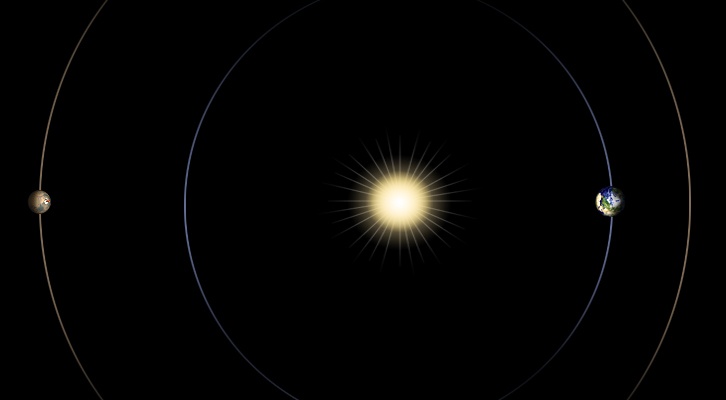Every two years, Mars enters what is known as a “Solar Conjunction,” where its orbit takes it behind the Sun relative to Earth. During these periods, the hot plasma regularly expelled by the Sun’s corona can cause interference with radio signals transmitted between Earth and Mars. To avoid signal corruption and the unexpected behaviors that could result, NASA and other space agencies declare a moratorium on communications for two weeks.
What this means is that between Oct. 2nd and Oct. 16th, all of NASA’s Mars missions will experiencing what is known as a “commanding moratorium.” This will consist of NASA sending a series of simple commands to its missions in orbit, which will then be dispatched to landers and rovers on the surface. These simple tasks will keep all of the robotic Martian explorers busy until regular communications can be established.
This moratorium can be extended by a day or two in either direction, depending on the angular distance between Mars and the Sun in the sky. “Though our Mars missions won’t be as active these next few weeks, they’ll still let us know their state of health,” Roy Gladden, manager of the Mars Relay Network at NASA’s Jet Propulsion Laboratory. “Each mission has been given some homework to do until they hear from us again.”

During the moratorium, the robotic missions will transmit a limited amount of science data back to Earth (with the understanding that some will be lost), but most of it will be saved until after Mars is no longer in conjunction. At that time, the remaining data will be beamed to Earth using the Deep Space Network (DSN), the array of Earth-based radio antennae NASA uses to communicate with its deep-space missions.
In the meantime, NASA’s three orbiters – the Mars Odyssey, Mars Reconnaissance Orbiter (MRO), and the Mars Atmosphere and Volatile EvolutioN (MAVEN) orbiter – will keep relaying some data from the missions on the surface, and also gather their own data. As for what the surface missions will be doing, the Perseverance rover will conduct weather measurements with its Mars Environmental Dynamics Analyzer (MEDA).
This will include looking for dust devils with its sensors and Mast-Mounted Camera System (Mastcam-Z), making radar scans with its Radar Imager for Mars’ Subsurface Experiment (RIMFAX), and recording new sounds with its microphones. The Ingenuity Mars Helicopter will remain at its current location, 175 meters (575 feet) away from Perseverance, and communicate its status weekly to the rover.
Over in the Gale Crater, the Curiosity rover will also be on the lookout for dust devils using its suite of cameras. It will use its Rover Environmental Monitoring Station (REMS) sensors to monitor the local weather conditions. It will also use its Radiation Assessment Detector (RAD) and Dynamic Albedo of Neutrons (DAN) sensors to take radiation measurements. The InSight lander will continue to monitor for “marsquakes” using its seismometer, similar to the three large ones it detected recently.
In all cases, the mission controllers will choose which instruments to shut down or keep in operation, depending on the type of mission they’re supporting. They will also decide what to do with the collected data – store it and wait until after the moratorium to transit it or transmit it and risk some data loss. Regardless, no new instructions are ever sent to Mars during a Solar Conjunction since a loss of information in a command sequence could potentially endanger a mission.
It is precisely for this reason that the moratorium procedure was developed, where mission controllers send two weeks’ worth of instructions before the conjunction and then wait. The ability of the orbiters, landers, and rovers to look after themselves during this time is a testament to how far the technology has advanced. When it is not safe to send instructions to distant missions, engineers can engage the autopilot and take some well-deserved vacation time!
Further Reading: NASA
https://news.google.com/__i/rss/rd/articles/CBMiaWh0dHBzOi8vd3d3LnVuaXZlcnNldG9kYXkuY29tLzE1Mjc4Mi9jb21tdW5pY2F0aW9uLXdpdGgtbWFycy1pcy1hYm91dC10by1iZWNvbWUtaW1wb3NzaWJsZS1mb3ItdHdvLXdlZWtzL9IBbWh0dHBzOi8vd3d3LnVuaXZlcnNldG9kYXkuY29tLzE1Mjc4Mi9jb21tdW5pY2F0aW9uLXdpdGgtbWFycy1pcy1hYm91dC10by1iZWNvbWUtaW1wb3NzaWJsZS1mb3ItdHdvLXdlZWtzL2FtcC8?oc=5
2021-10-03 18:30:46Z
CBMiaWh0dHBzOi8vd3d3LnVuaXZlcnNldG9kYXkuY29tLzE1Mjc4Mi9jb21tdW5pY2F0aW9uLXdpdGgtbWFycy1pcy1hYm91dC10by1iZWNvbWUtaW1wb3NzaWJsZS1mb3ItdHdvLXdlZWtzL9IBbWh0dHBzOi8vd3d3LnVuaXZlcnNldG9kYXkuY29tLzE1Mjc4Mi9jb21tdW5pY2F0aW9uLXdpdGgtbWFycy1pcy1hYm91dC10by1iZWNvbWUtaW1wb3NzaWJsZS1mb3ItdHdvLXdlZWtzL2FtcC8
Tidak ada komentar:
Posting Komentar